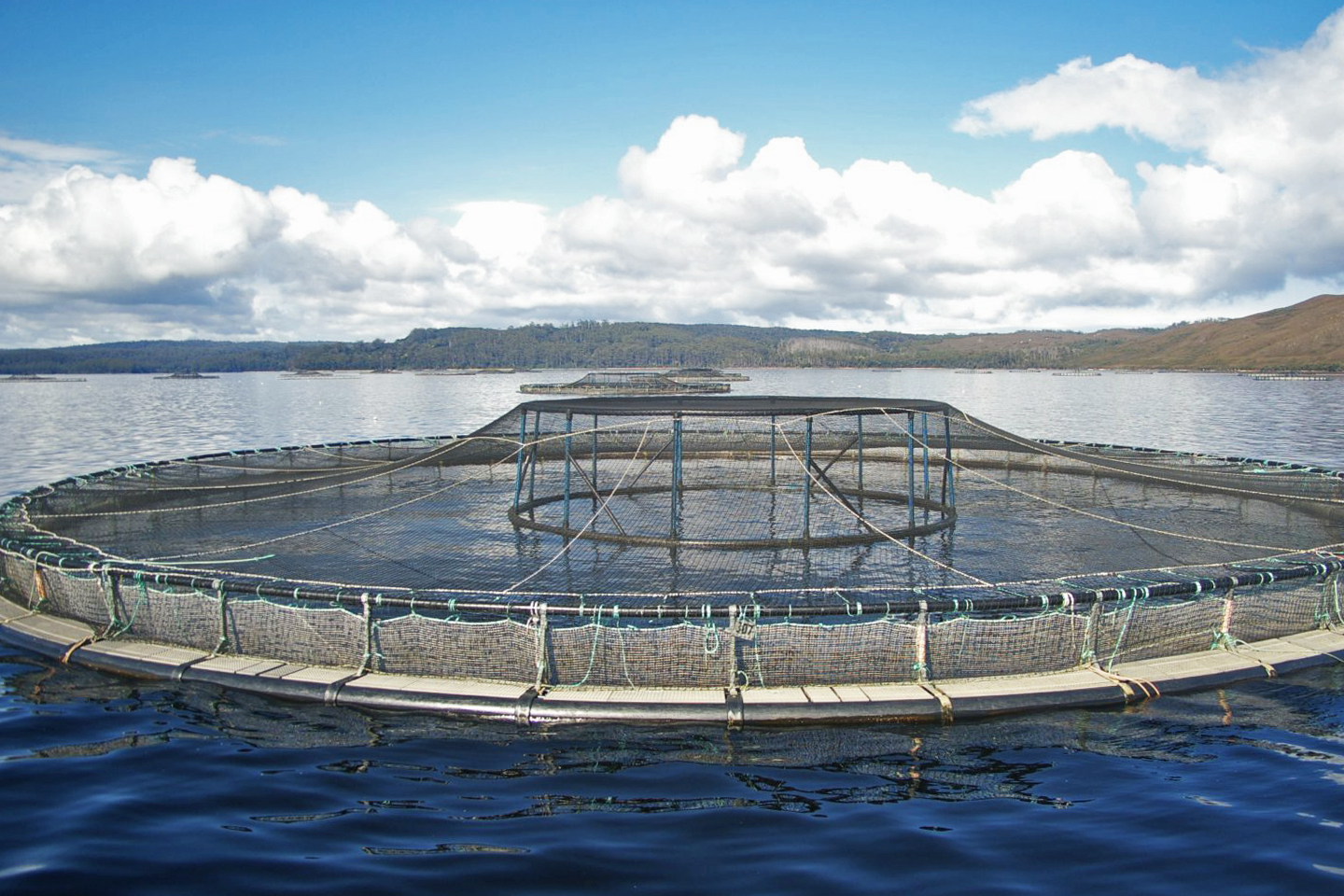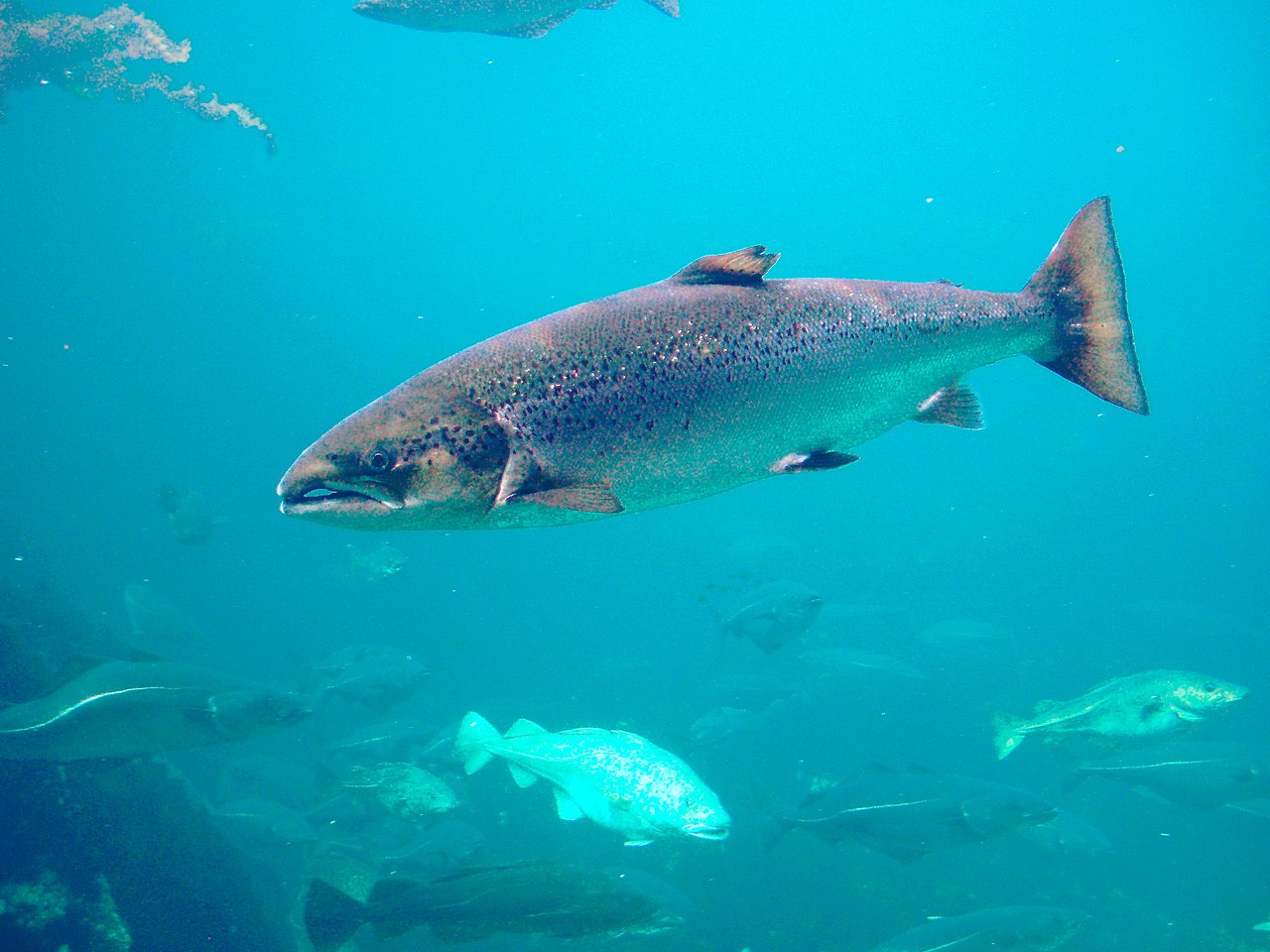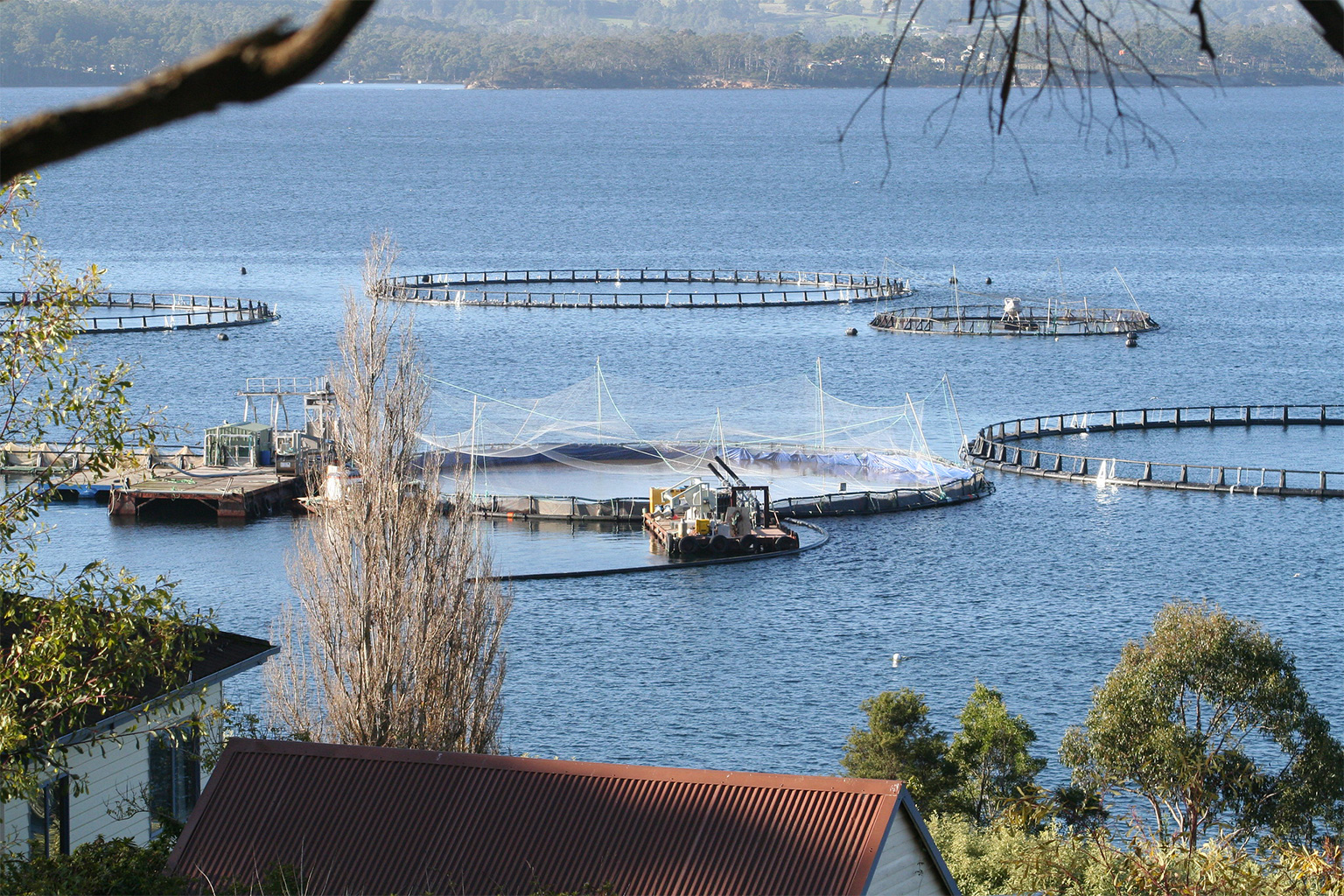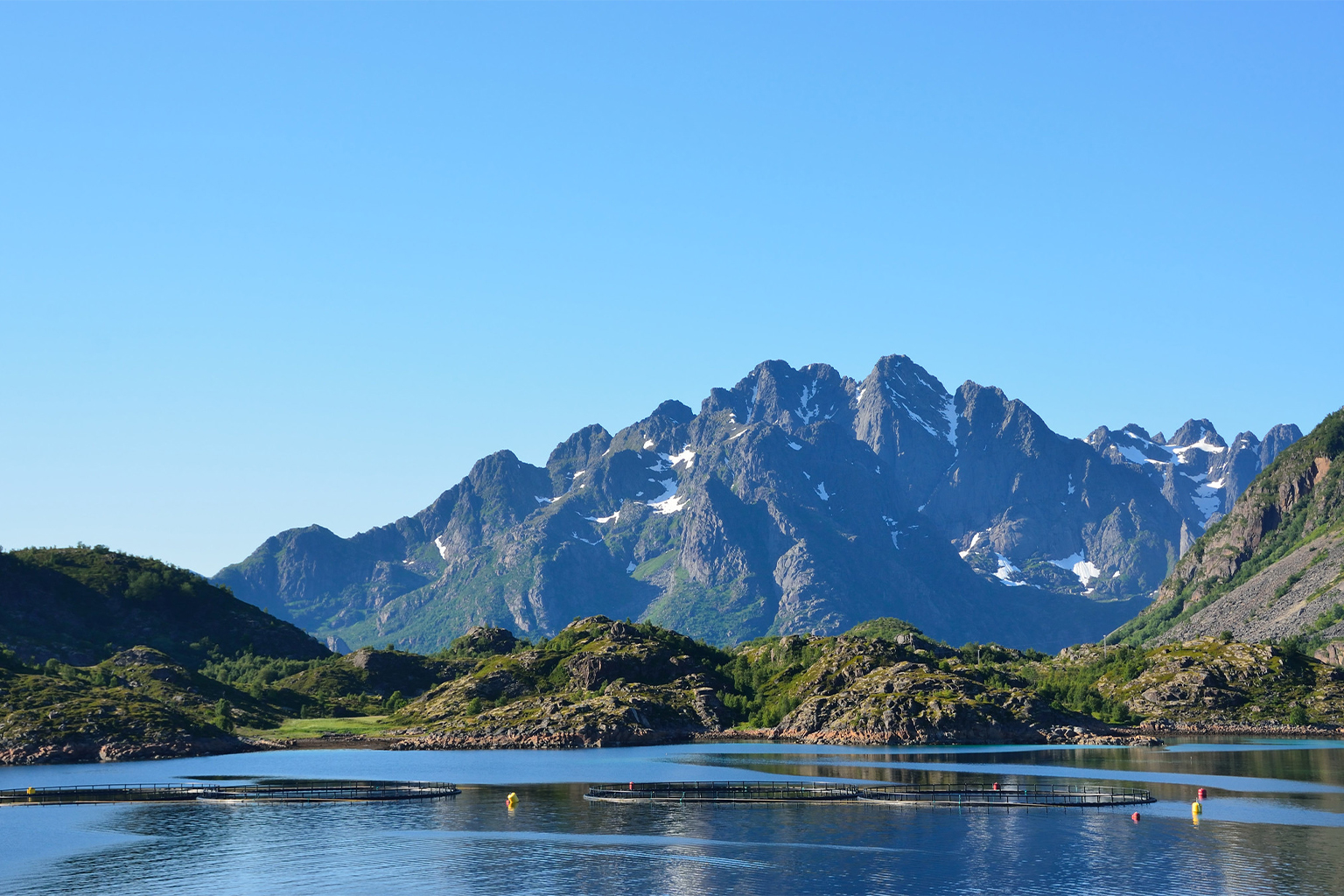- Aquaculture produces more than half of the world’s seafood, mostly in inland and coastal waters. Industrial marine and coastal finfish aquaculture, such as salmon farming, accounts for just a fraction of that production, and comes with a host of negative environmental impacts.
- A set of agribusiness giants and other corporate interests are pushing to expand industrial finfish aquaculture into U.S. federal waters — the open seas — where proponents argue that it will help feed a growing global demand for seafood and have less environmental impact. They want Congress to pass legislation establishing a federal aquaculture system.
- Though Congress has not yet acted, in 2020, Donald Trump issued an executive order that gave the industry a boost, and government agencies have begun the permitting process for several projects in which finfish would be raised in open-ocean pens miles out to sea.
- Environmental advocates, including the campaign group Don’t Cage Our Oceans, are fighting against the proposed congressional bills, calling for a reversal of the executive order and a stop to the proposed projects in U.S. federal waters.
Perhaps the most notorious industrial farming institution is the concentrated animal feeding operation, or CAFO, in which livestock are raised in crowded conditions that require the heavy use of antibiotics to treat the infections that inevitably arise from such packed and stressful living. In recent decades, as a growing proportion of the world’s seafood has come from aquaculture, corporate actors have begun to take the same industrial food production tactics to the world’s waters, according to environmental and Indigenous rights activists.
While some aquaculture has social and environmental benefits, farming carnivorous finfish on an industrial scale has numerous negative impacts: chemical and nutrient pollution, overfishing of forage fish to feed penned fish, threats to Indigenous and small-scale fisher livelihoods, and the increased spread of infections causing harm to wild fish.
So far, industrial aquaculture has been limited to coastal or inland waters, but now there’s a push to expand it into the open seas, where proponents say it can help feed a growing global demand for seafood with less environmental impact than coastal aquaculture, being farther from sensitive coastal habitats and creating less concentrated pollution in deeper, higher-flow waters.
In June, a bill known as the AQUAA Act was reintroduced to both the U.S. Senate and House that would establish regulatory standards and investment in research and technology for an industrial aquaculture system in federal waters. Stronger America Through Seafood (SATS), an industry group that includes agribusiness giants such as Cargill, Merck Animal Health and Sysco, support the bill.
Though its passage is uncertain, as similar efforts have failed in the past, the federal government is already taking steps to develop offshore aquaculture, even without congressional action. In 2020, then-president Donald Trump issued an executive order that gave the industry a boost, and government agencies have begun the permitting process for several projects in which commercially valuable fish such as salmon would be raised in open-ocean pens miles out at sea. While coastal finfish aquaculture already exists in some state waters, these would be the first projects of their kind in federal waters, which extend from 3 to 200 nautical miles (6 to 370 kilometers) offshore in most cases.

In May, campaigners from Don’t Cage Our Oceans (DCOO) and Block Corporate Salmon, coalitions of advocacy groups that oppose offshore finfish aquaculture, delivered a petition calling on the Biden administration to reverse the Trump executive order. In June, they condemned the reintroduced congressional bill, which they say will “streamline the process for corporations to develop additional facilities.”
They refer to the proposed projects as “floating CAFOs” and say there’s little independent research to support the argument that offshore industrial aquaculture, which is in its infancy, will be less damaging than inshore has been. In fact, they argue that offshore aquaculture could present new dangers, including the effective privatization of oceans for corporate use and the disruption of wild migration patterns as fish and marine mammals aggregate around farms.
George Kimbrell, legal director at the Center for Food Safety (CFS) and the co-author of a new law review article on the “coming battle for the ocean,” told Mongabay that U.S. policymakers should learn from what’s happened on land — corporate control and dense concentrations of a single crop — and avoid adopting the same model at sea. There are still small- and medium-scale fishing communities across the country that rely on access to healthy marine ecosystems, he said.
“All that’s gone if you have industrial aquaculture replace it,” he said. “All you have to do is drive across Iowa[’s fields] and you see what it’s replaced with.”

Raising the alarm on raised fish
Aquaculture dates back millennia and, in many forms, can be regenerative for surrounding ecosystems, especially if seaweed, shellfish or herbivorous finfish are being raised. But industrial aquaculture, which uses antibiotics, pesticides, fungicides, antifoulants and hormones, has little in common with traditional or small-scale practices, Kimbrell said. Such treatments can create a vicious cycle, with more and more needed, he told Mongabay. For example, emamectin benzoate, an insecticide commonly used to kill sea lice in salmon farms, is losing its effectiveness, according to a 2022 study in the journal Scientific Reports.
Aquaculture, fueled by investor interest and consumer demand, has been the fastest-growing food production sector in the world over the past three decades, most of it in inland and coastal waters outside the U.S. More than half of the world’s seafood now comes from aquaculture.
The negative consequences of this shift are clear, and are a sign of what’s to come if offshore waters are also opened up to industrial aquaculture, campaigners say.
“[T]he United States should pay attention and learn the lesson that others had to learn the hard way,” Andrianna Natsoulas, DCOO’s campaign director, told Mongabay.
In 2021, Argentina effectively banned industrial salmon farms following the death of millions of salmon at aquaculture sites in neighboring Chile. Denmark has also halted the development of fish farms in its waters due to environmental concerns. In the U.S., the Washington state legislature banned farming of Atlantic salmon in 2018 and a state official recently banned all commercial finfish aquaculture. Alaska and California have similar bans.
If coastal industrial finfish aquaculture has come with negative environmental impacts, it’s not yet clear how offshore aquaculture will compare, as there are very few studies on the subject.
From what has been studied, it does appear that offshore sites could emit less concentrated nutrient pollution from fish waste and excess feed, which can lead to harmful algal blooms. One offshore site in Panamanian waters showed minimal nutrient pollution.
A 2019 report from The Nature Conservancy, an environmental NGO, and Encourage Capital, an investment firm, advocated for the use of offshore fish farms as a more sustainable alternative to industrial aquaculture. The authors cite a study that indicates that water quality is not affected at a distance of more than 90 meters (about 300 feet) from an offshore site.
The National Oceanic and Atmospheric Administration (NOAA), an agency that’s part of the U.S. Department of Commerce, supports the development of offshore aquaculture as a way of meeting global seafood demand.

“As the global population continues to rise, global wild-capture fisheries have plateaued over the last 30 years. Wild fish harvests simply cannot meet growing seafood demand,” Katie Wager, a NOAA spokesperson, told Mongabay as part of an emailed statement.
Proponents also say it’s a sustainable way to produce seafood and that negative public perceptions are based on misinformation. SATS, the industry group, disputes the arguments put forth in the article by Kimbrell and his co-author.
“It’s time to move past the outdated myths that have stilted an aquaculture industry in the U.S. and look to harness the vast potential of our ocean waters,” Drue Banta Winters, SATS’s campaign manager, told Mongabay as part of an emailed statement. “The authors miss the mark on the environmental impacts of aquaculture and [rely] on outdated science to make their anti-aquaculture argument. Today’s modern fish farming is sustainable and produces high quality, healthy fish with minimal environmental impact.”
The SATS statement also cited aquaculture’s role in feeding a growing U.S. population. Most seafood consumed in the U.S. comes from abroad, and aquaculture sites in federal waters could provide more homegrown seafood, reducing the trade deficit, they say.
However, opponents say there’s already plenty of catch in the U.S. without offshore aquaculture, but much of it is exported for sale to foreign consumers or for processing overseas. In 2020, the U.S. industrial seafood catch was about 8.4 billion pounds (3.8 million metric tons), while national consumption was about 6.3 billion pounds (2.9 million metric tons), according to NOAA’s “Fisheries of the United States” report.
To meet growing seafood demand, DCOO also advocates alternatives to offshore aquaculture including local wild catch, recirculating systems, and other low-input, low-impact forms of aquaculture that provide social and economic benefits to local and Indigenous communities.


A wave of offshore projects
More than a dozen countries have commercial offshore finfish farms, including Norway, Mexico and China, that range from small-scale pens to industrial-scale systems. Other countries are in the experimental and development phase of this industry, some looking at new mega-scale technologies similar in size and scale to offshore oil rigs to build robust submersible pens in the deep, turbulent ocean waters. Salmar’s Ocean Farm 1 in Norway is a leader in offshore development, harvesting 10,000 metric tons of salmon in two farming cycles, and Nippon Steel’s system in Japan includes underwater monitoring cameras and an innovative automatic feeding system.
Five projects have already been proposed in U.S. federal waters, two of which are off Florida’s Gulf Coast. The furthest along in the permitting process with federal agencies is a project to farm red drum (Sciaenops ocellatus), a fish native to the Gulf of Mexico, about 72 kilometers (45 miles) off Sarasota; it would be a relatively small operation with one submersible pen. A multi-finfish project off Pensacola would have 12 pens and cover 158 hectares (390 acres). The Gulf is also where NOAA has designated many of its “aquaculture opportunity areas” — places deemed suitable for future projects.
Residents of Florida’s Gulf Coast already deal with harmful algae blooms, known as “red tide,” that are toxic to people, marine mammals, fish, birds and shellfish. Christian Wagley, a Pensacola-based organizer for Healthy Gulf, a marine conservation NGO, said he worries that industrial aquaculture will make this problem even worse, damaging tourism and other sectors of the economy. He said there are also concerns about the project’s potential impact on Rice’s whale (Balaenoptera ricei), a critically endangered baleen whale. Similar whales have become entangled in aquaculture gear in New Zealand, and fish farms also raise the risk of vessel strikes on whales, according to a NOAA information webpage.
Wagley said he believes it’s important to act now, before the industry gets established.
“People can make the argument ‘Oh, it’s just one farm,’ but … the model depends on scaling up,” he told Mongabay. “Any business will tell you it’s about economies of scale. They have to get bigger to bring down the costs of production. There was never going to be just one oil rig in the Gulf, and there’s never going to be just one fish farm.”

Off Newburyport, Massachusetts, a large, 40-pen proposed trout and salmon project has also caused concern. Brett Tolley, who comes from a long line of fishers on Cape Cod and is a national coordinator at North American Marine Alliance, a fisher-led advocacy group, opposes the project and said the federal government is taking the wrong approach.
“It doesn’t make any sense to prioritize investing money into industrial aquaculture,” he told Mongabay. “It makes a lot more sense to rebuild local and regional seafood supply chains, and if we could do that then families like mine could be around for the long haul.”
Carl Wassilie, a Yupik biologist who lives in Washington state where commercial finfish farming is banned, said such state restrictions are key not just for the environment but also for the cultural vitality of Indigenous fishers.
“[There’s a] spiritual importance of being able to get that salmon, do a ceremony or to share with their elders, especially for a young fisherfolk, the importance of honoring our salmon and all the relations that the salmon have with the bear, the eagle, even the berries,” he told Mongabay, referring to the interconnectedness of the natural world for Indigenous peoples of the Pacific Northwest.
Wassilie said the struggle against industrial aquaculture in the U.S. is part of a larger Indigenous resistance, this time against the attempted privatization of the oceans for use by corporations and the risk of cascading effects if the industry scales up. So far, the proposed projects in federal waters are not near Indigenous fishing waters.
The consequences of a finfish aquaculture build-out could be dire, Kimbrell said. “[I]s the future of our oceans doubling down on the tragedy of industrial agriculture?” he and his co-author write in the final section of the law review article. “In 30 years, will [federal waters] look like a watery version of an Iowa cornfield or a North Carolina pig CAFO?”
UPDATE (June 26, 2023): A bullet point was updated to clarify that ‘marine and coastal’ finfish aquaculture accounts for a fraction of aquaculture. The SATS’s campaign manager’s name has also been corrected from Drue Banta Williams to Drue Banta Winters.
Banner image: Fish farm in Saronic Gulf, off the Greek coast. Image by Artur Rydzewski via Flickr (CC BY 2.0).
Related podcast listening:We look at Indigenous peoples’ long relationship with, and stewardship of, marine environments through two stories of aquaculture practice in New Zealand and Canada. Listen here:
Amid aquaculture boom, report guides investors toward sustainability
Citations:
Kimbrell, G. A., & Stevenson, M. L. (2023). Ensnared: 21st-Century Aquaculture Law and the Coming Battle for the Ocean (53 ELR 10383). Environmental Law Reporter. Retrieved from https://www.eli.org/sites/default/files/files-pdf/May%20ELR%202023%20Feature%20Article.pdf
Godwin, S. C., Bateman, A. W., Kuparinen, A., Johnson, R., Powell, J., Speck, K., & Hutchings, J. A. (2022). Salmon lice in the Pacific Ocean show evidence of evolved resistance to parasiticide treatment. Scientific Reports, 12(1), 4775. doi:10.1038/s41598-022-07464-1
Welch, A. W., Knapp, A. N., El Tourky, S., Daughtery, Z., Hitchcock, G., & Benetti, D. (2019). The nutrient footprint of a submerged‐cage offshore aquaculture facility located in the tropical Caribbean. Journal of the World Aquaculture Society, 50(2), 299-316. doi:10.1111/jwas.12593
Froehlich, H. E., Smith, A., Gentry, R. R., & Halpern, B. S. (2017). Offshore aquaculture: I know it when I see it. Frontiers in Marine Science, 4, 154. doi:10.3389/fmars.2017.00154
Fujita, R., Brittingham, P., Cao, L., Froehlich, H., Thompson, M., & Voorhees, T. (2023). Toward an environmentally responsible offshore aquaculture industry in the United States: Ecological risks, remedies, and knowledge gaps. Marine Policy, 147, 105351. doi:10.1016/j.marpol.2022.105351
